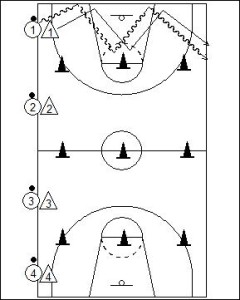Defensive Lane Drill
The Defensive Lane Drill brings some much needed competition to any training session. The Defensive Lane Drill is a fantastic drill for building desirable characteristics in both offensive and defensive players. When conducted at game pace the Defensive Lane Drill will provide some vital insight into your players ability to deal with pressure when dribbling the ball and give opportunities for your defensive players to demonstrate their effort.
Because the Defensive Lane Drill is a competitive drill the faster and harder your players push one another the more benefit there will be achieved.
The Defensive Lane Drill starts will players on a sideline and matching up one on one. The drills sees each player interchanging between offense and defence on each trip across the floor. To help with the dual development of the Defensive Lane Drill the following points have been split into offense and defence.
Offensive Keys
Ensure that offensive players are going a game pace; offensive players have a tendency to pull-up and allow the defence to recover once they have beaten the player. This needs to be avoided at all costs and dribblers should be encouraged to beat the player and dribble through the sideline at full pace (providing out of bounds space is suitable).
Dribblers must always continue to move forward; in a game one of the worst habits often displayed is over dribbling of the basketball and this is compounded if the dribbles are happening on the spot. When dribbling the ball the offensive player should always be moving forward helping establish momentum in the defensive player which can be used against the defender through change of direction and pace.
Encourage dribbler to utilise a number of different dribbling techniques; while not always suitable in game scenarios to help with continued player development of technical skills ask your players to use a range of dribbles such as cross-overs in front, cross-overs through the legs, behind the back and spin dribbles. Depending on your philosophy or preference these might never be used in a game but should be practiced to give the greatest range of skills available to the offensive player.
Defensive Keys
Encourage acceptable risk taking; encourage your defensive players to take risks in trying to turn the offensive player. Depending on your philosophy this might even include attempting to try and steal the ball. The Defensive Lane Drill is about helping your defensive players develop the ability to turn the ball. If your players never feel any risk is acceptable they cannot and will not develop the ability to defend to their full potential. This type of mentality also stifles your players range of experiences under which they will look to develop the knowledge of what is an “acceptable” and “unacceptable” risk.
Beat the offensive player to a spot; once the offensive player has been turned the defensive player must look to regain position and turn the player again. This is done by the defensive player coming out of a defensive stance and sprinting to a spot ahead of the dribbler and ultimately the ball. Ensure the defensive player does not push onto the hip of the dribbler or this in a game will be a foul.

Players go 1 v 1 across the court (cones mark the out of bounds).
Drill is repeated back across the court change offensive defensive roles.
When setting up the drill try to match-up players based on speed. The more closely aligned players are in foot speed, the more challenging this drill will be for offensive and defensive players.
This situation can be changed up to help extend players by matching them up against faster players if their ability in handling pressure needs to be developed. This is especially useful for developing ball handlers like your team’s Point Guards.
Points of Emphasis
- Defensive player must beat the offensive player to the spot if beaten or after turning the dribbler
- The trail hand of the defensive player should be low to be ready for crossover of the ball
- Defensive player must keep their noise on ball – turn the ball as often as possible
- Game pace
Variations
- Increase the width of the lane for greater challenge to the defensive player
- Set a target for the number of times an offensive player must be turned by the defence
- Set a target for the maximum amount of drills the offensive player is allowed to have






Leave a Reply